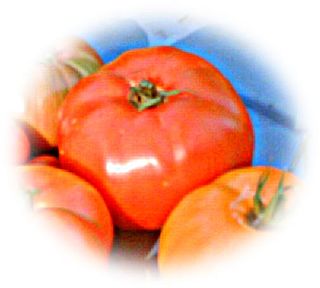
A beef tomato or beefsteak tomato is one of the largest varieties of cultivated tomatoes, some weighing 450 grams (1 lb) or more. Most are pink or red with numerous small seed compartments (locules) distributed throughout the fruit, sometimes displaying pronounced ribbing similar to ancient pre-Columbian tomato cultivars. While popular among home growers for beef sandwich toppings and other applications requiring a large tomato such as toppings on large steaks, beefsteaks are not grown commercially as often as other types, since they are not considered as suitable for mechanization as smaller slicing tomatoes.

Green Zebra is a tomato cultivar with characteristic dark green and yellow stripes. Newer variations blush reddish instead of yellow when ripe. It is more tart than regular tomatoes, and it is an early cultivar. Compared to other tomato varieties, it can produce somewhat mealy fruits depending on growing conditions.

The Brandywine tomato plant is an heirloom cultivar of the species, with large potato-leaved foliage and which bears large pink beefsteak-shaped fruit, popularly considered among the best tasting available.

The tomato is the edible, often red, berry of the plant Solanum lycopersicum, commonly known as a tomato plant. The species originated in western South America. The Nahuatl word tomatl gave rise to the Spanish word tomate, from which the English word tomato derived. Its use as a cultivated food may have originated with the indigenous peoples of Mexico. The Spanish encountered the tomato from their contact with the Aztec during the Spanish colonization of the Americas and brought it to Europe. From there, the tomato was introduced to other parts of the European-colonized world during the 16th century.

Cherokee Purple is the name of a cultivar of tomato that develops a fruit with a deep, dusky-rose color while maintaining a somewhat greenish hue near the stem when mature for eating. The deep crimson interior and clear skin combination give it its distinctive color. It was one of the first of the darker color group of tomatoes sometimes described as "blacks"; the variety Purple Calabash, with its highly irregularly shaped fruits, arose in a very few seed catalogs in the mid 1900s. Southern Exposure Seed Exchange was the first seed company to offer Cherokee Purple, released in limited quantity in 1993.

Tigerella is a bi-colored tomato cultivar, relatively small, 2 to 4 ounces, and early. Upon maturity the fruit is red with yellow stripes, essentially the same as Green Zebra, except that the fruit is red instead of green, and has a sweeter flavor. The colour occasionally varies, in New Zealand for instance, commercially produced Tigerella is dark crimson red with very dark green stripes.

Mr. Stripey is a type of heirloom tomato with unusually small leaves and a mix of a yellow and red color that can fool some growers into thinking they are picking an unripe tomato. Under good conditions in size, shape and internal structure it may be considered a "beefsteak".Tigerella is generally smaller than the Mr Stripey variety and the colors are less defined, they actually are two distinct different heirloom varieties. Tigerella isn't as sweet or "low-acid" as the Mr Stripey variety either. Like other heirlooms, Mr. Stripey has an appearance that differs considerably from other tomatoes. In coloration it is generally somewhat more yellow near the stem and more red towards its underside, with gentle stripes of red and yellow blending into each other along the sides. This coloration may extend into the interior of the fruit, which tends to be more yellow than red.

Pear tomato or Corn Seed is the common name for any one in a group of indeterminate heirloom tomatoes. It originated in Europe in the 18th century. There are yellow, orange, and red varieties of this tomato; the yellow variety being most common. They are generally sweet, and are in the shape of a pear, but smaller. They are heirlooms and have 3 common other names, such as the "Red/Orange/Yellow Pear Tomato Plants."
The Big Rainbow heirloom tomato is one of dozens of large fruited yellow tomatoes with red swirls. They have a mild, sweet flavor. The Hillbilly tomato is another similar-coloured tomato.

The Black Krim is an heirloom tomato originating from Russia. The plant is open-pollinated, indeterminate, bearing 8 ounce flattened globe fruits that are dark reddish-purple to black with green/brown shoulders.
The Hillbilly Tomato, also known as the "hillbilly potato leaf tomato", scientific name Solanum lycopersicum, is an heirloom cultivar originating from West Virginia in the 1800s. This fruit is considered a beefsteak tomato weighing 1-2 pounds. It is round, heavily ribbed and its skin and flesh is orange- yellow with red streaks. The flavor is described "sweet and fruity" and is low in acid.
The Jubilee cultivar of tomato is heavy yielding, low acid, with golden fruit that grow on indeterminate vines. It was released by Burpee Seeds in 1943.
Lillian's Yellow tomato is a late season heirloom tomato collected by Lillian Bruce of Tennessee. She gave seeds to Robert Richardson, after which it found its way into the Seed Savers Exchange yearbook. One of the few bright yellow varieties, Lillian's Yellow Tomato is a potato leaved plant that requires a long growing season. The fruit is meaty, full flavored and contains few seeds.
The Arkansas Traveler is an open-pollinated heirloom variety of tomato that was bred by the University of Arkansas in 1968. The plant is indeterminate with round red fruits weighing approximately 6 ounces.
The Amish Paste heirloom tomato is, as the name implies, a plum tomato of Amish origins, that is commonly used for cooking, although it's sweet enough to eat fresh.

Aunt Ruby's German Green heirloom tomatoes are a cultivar originating with Ruby Arnold, of Greeneville, Tennessee, but achieving great Seed Savers popularity. They are, as the name implies, "green" tomatoes, which really means they are a greenish yellow when fully ripe, but are still tasty when picked early.
Azoychka is a yellow Russian beefsteak heirloom tomato. The regular multi-locular structure distinguishes it from brandywine types.












